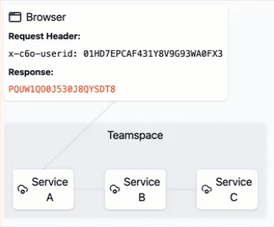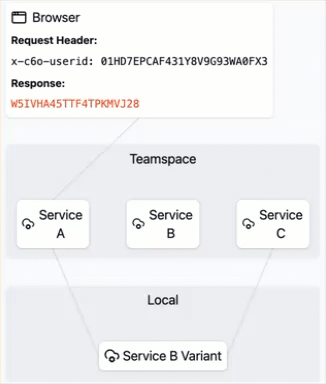The promise of Zero Environment Development (ZED) is transformative: develop locally with the speed and tools you love, while seamlessly interacting with your cloud-native applications as if your local machine is part of the Kubernetes cluster. At Codezero, we're passionate about making ZED a reality. But with any powerful new approach, the question often arises: "Where's the best place to start?"
Choosing the right initial use case can help showcase the benefits of Codezero and pave the way for broader adoption within your team. Let's dive into what we consider an ideal pilot project.
The Familiar Challenge: Wrestling with a Single Microservice in a Complex System
Picture this common scenario: your company has a sophisticated multi-service application—perhaps five, ten, or even more microservices, all humming along in a shared Kubernetes development or staging cluster. A developer, let's call her Sarah, needs to jump in to develop a new feature for, or debug an issue in, just one of those services—we'll call it: "Service B".
Service B isn't an island; it depends on Service A, Service C, and potentially a host of other services and data stores running within that same Kubernetes cluster.

Sound familiar? Now, consider the challenges Sarah faces without Codezero:
- The Local Labyrinth: Attempting to run the entire application stack locally can be a
significant challenge. Even just running part of the app stack locally is a pain. It's resource-intensive, complex to configure, and prone to the infamous "works on my machine" syndrome.
-
The "Deploy-to-Test" Slog: Continuously deploying every minor code change of Service B to the shared Kubernetes cluster just for testing is just s_l_o_w.... It breaks the development flow and can inadvertently disrupt other team members relying on that shared environment.
- Port-Forwarding Purgatory: Manually setting up and managing
kubectl port-forward commands for every single dependency (Service A, Service C, databases, message queues) is cumbersome, error-prone, and needs constant readjustment.
These hurdles are exactly what Codezero is designed to eliminate.
The Codezero Solution: Your First Pilot Project – Streamlining Single Service Development
The ideal starting use case for Codezero directly tackles the scenario above: empowering Sarah to develop and debug Service B locally, while remaining seamlessly connected to its dependencies running in the shared Kubernetes cluster.
Here’s how Codezero transforms her workflow:
- Connect to the Teamspace: Sarah installs the Codezero CLI or Desktop application on her local machine. She then connects to the Kubernetes cluster where the multi-service application is running. This cluster now acts as her Codezero "Teamspace," a collaborative development environment.
- "Consume" Dependencies with Ease: Using a simple
czctl consume command (or a few clicks in the Desktop app), Sarah instantly makes Service A, Service C, and any other required services or resources from the Teamspace available to her local environment. Codezero transparently handles the complex networking, making these remote services appear as if they're running right on her machine. (You can learn more about this in our Consuming Services Documentation).
- "Serve" Her Local Service: Sarah fires up the code for
Service A locally, using her favourite IDE, debugger, and development tools. With another straightforward command, czctl serve namespace/service-A 8000 (or via the Desktop app), she instructs Codezero to intelligently route traffic intended for Service A, within the context of her development session or based on specific routing rules she defines, from the Teamspace directly to her local instance. (Check out the details in Serving Variants ).
- Iterate at Lightning Speed: This is where the magic happens. Sarah can now make code changes to
Service B locally and test them immediately. She can interact with the entire application (requests might originate from other services in the Teamspace and flow to her local Service B), set breakpoints, and debug in real-time. Her inner development loop becomes incredibly fast and efficient.

Why This is the Perfect Starting Point
Focusing on this "single local service, multiple remote dependencies" pattern for your first Codezero project offers several advantages:
- Addresses a Universal Pain Point: Almost every team working with microservices feels the friction of developing individual components within a larger, interconnected system.
- Highlights Core Codezero Benefits: It perfectly showcases Codezero's power to simplify access to cluster dependencies and seamlessly integrate local development with a remote, shared environment.
- Low Barrier to Entry: The pilot can start small, perhaps with just Sarah and her
Service A. This makes it easier to learn the workflow and understand the benefits without the pressure of a large-scale, team-wide rollout.
- Delivers Clear, Immediate Value: Developers like Sarah will quickly see a dramatic improvement in their development speed, a significant reduction in environment setup headaches, and a much more enjoyable coding experience.
- Leverages Your Existing Infrastructure: Codezero works with your current Kubernetes clusters (or VMs in a VPC!); there's no need to build something entirely new to get started.
Ready to Get Started?:
- Identify: Select a suitable microservice and a developer (or small team) eager to improve their workflow.
- Set Up Teamspace: Have your DevOps team install the Codezero Space Agent into your existing Kubernetes development cluster, instantly turning it into a Teamspace.
- Install Locally: The developer installs the Codezero local agent .
- Consume & Serve: The developer uses Codezero to consume remote dependencies and serve their local service variant.
- Test, Iterate, and Enjoy!
This focused approach allows your team to experience the power of ZED by dramatically improving the inner development loop for a common, often frustrating, task. It's an excellent way to introduce, evaluate, and build enthusiasm for Codezero.
You can try all this locally with our live Tutorial app or sign up for a Free Teamspace today.
Ready to give it a try and say goodbye to environment complexity?